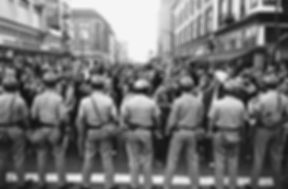
1960 — Students protest the execution of Caryl Chessman
Chessman — notorious thief, rapist, author and international cause celebre
On February 17, 1960 a rally was held in Union Square, San Francisco, in support of a world-wide appeal for clemency for Caryl Chessman, a career criminal who had been jailed on multiple occasions. He was convicted in 1948 of robbery, rape and kidnapping charges that led him to be sentenced to death under California's "Little Lindbergh" law. By 1960, Chessman had been on death row for twelve years, claimed innocence after initially confessing, and had filed numerous appeals of his conviction, none successful. He had received eight stays of execution, some coming at the last minute. While in prison, Chessman wrote four books about his case and the criminal justice system, the most successful of which was his memoir, Cell 2455, Death Row.
Chessman's books and courtroom dramas gained him the sympathy of a number of Hollywood celebrities, American writers and other respected figures, including First Lady Eleanor Roosevelt, Evangelist preacher Billy Graham and French author and philosopher Jean-Paul Sartre. The attention paid to his case energized the growing movement in California against capital punishment.
The San Francisco rally, march to San Quentin and execution night vigil
Chessman's execution was set for February 19, 1960 at San Quentin State Prison in Marin County. At the February 17 rally for clemency for Chessman, held in Union Square, it was announced that there would be a march to the prison the next day, with an all-night execution vigil. The next day, a handful of protesters walked from San Francisco across the Golden Gate bridge and arrived at San Quentin as dusk was falling. They were met by a small group of anti-capital punishment protesters, there for the vigil.
The Chessman execution, delayed, then carried out
In the morning the protesters at the prison heard an announcement that Governor Pat Brown, an outspoken opponent of the death penalty, had granted Chessman a sixty-day stay of execution. Brown later explained that the reason for the stay was to "ensure the safety" of President Eisenhower during an official visit to South America, where the Chessman case was inflaming anti-American sentiment. After the announcement of the stay, the protesters left, still hoping for clemency or a successful appeal. When the stay expired in late April, the execution was rescheduled for May 2, 1960. There was another last-minute stay, but by the time it reached the officials at the gas chamber, the cyanide pellets had already dropped into the sulfuric acid beneath Chessman's chair, and the execution could not be stopped.
Anti-capital punishment demonstrators walk to the protest rally at San Francisco's Union Square.
February 17, 1960. Union Square, San Francisco. News vendor holds Chessman headline at his newsstand.
Demonstrators arrive at Union Square in San Francisco for the Chessman rally.
Dave Armor, UC Berkeley student body president, with picket sign protesting capital punishment.
Union Square, San Francisco. Local college students with home-made signs demonstrate against Chessman's scheduled execution. For many, this is their first public protest of any kind.
February 18, 1960, Palace of the Legion of Honor, San Francisco. A newsreel crew films a small capital punishment protest.
A Life magazine photographer takes pictures as the protesters leave San Francisco for the trek to San Quentin.
Student activist Bruce Benner leads a group of protesters across the Golden Gate Bridge to San Quentin prison.
Marin County. The protesters pick up a supporter (second from left) along the walk to the prison.
San Quentin prison grounds. The walkers arrive for the Chessman vigil. It rains heavily just before the group arrives at the prison.
San Quentin prison grounds. Snack time after the 12-mile trek from San Francisco. As dusk falls, this group meets up with an additional two dozen protesters there for the vigil.









